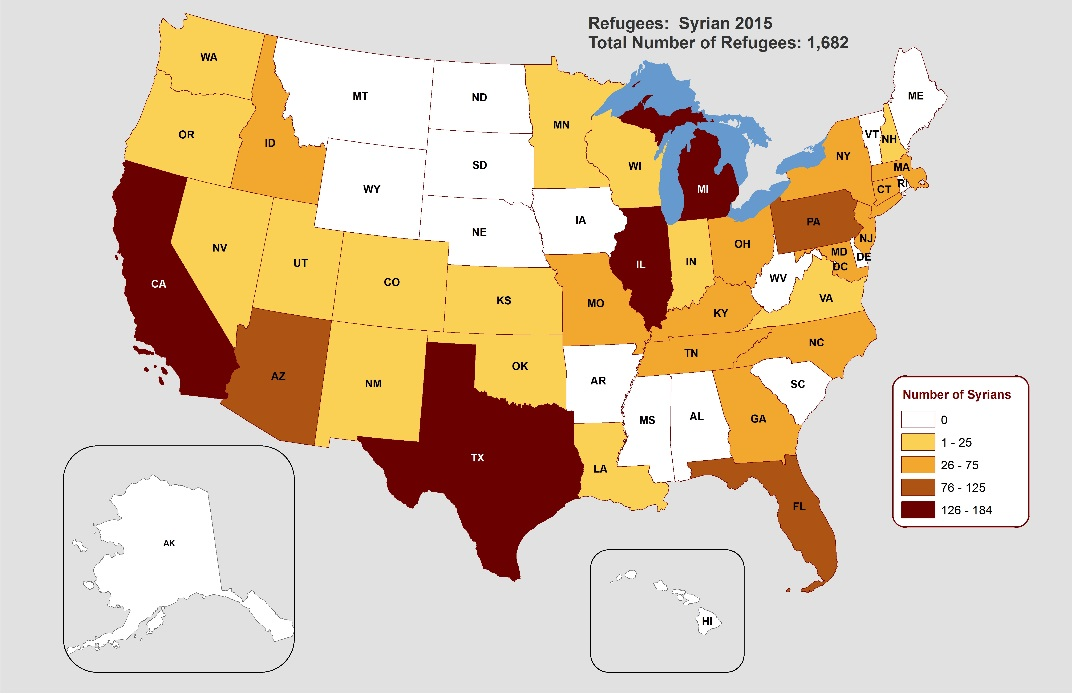Population Movements and Refugee Services in Countries of Asylum
Syrian Refugee Health Profile
On This Page
From Syria
By December 2015, the conflict in Syria had produced nearly 5 million registered Syrian refugees12. However, this figure only accounts for refugees who have been registered with UNHCR. The number of unregistered refugees throughout the Middle East will likely increase, as refugee camps have become overcrowded as the number of Syrian refugees grows. Syrian refugees are entering various countries to flee ongoing violence in their home country. Depending on the country of asylum, services available to Syrian refugees may vary and are likely to change substantially over time. Table 1 shows the estimated number of Syrian refugees in major countries of asylum, and discusses the living conditions and health services available to Syrian refugees in various countries. These estimates are based on UNHCR referrals for resettlement.
Table 1. Syrian refugee arrivals, living conditions, and access to health services by country of asylum
| Country of Asylum | Syrian Arrivals* | Living Conditions | Access to Health Services |
|---|---|---|---|
| Iraq | 227,971 | 38% camp 62% non-camp13 |
Specific services offered to select registered refugee populations14 15 16. |
| Jordan | 655,833 | 82% urban or informal settlements13 | Syrian refugees (registered with UNHCR) can access the public health system 17. |
| Lebanon | 1,017,433 | Urban areas (Beirut); Informal tent camps (Bekaa Valley); Sabra and Shatila camps (Beirut)18 | UNHCR registration is required for Syrian refugees to access primary healthcare services17. Registration of new arrivals was halted in May 2015 per the request of the Lebanese government12. |
| Turkey | 2,764,500 | Districts (known as a satellite cities); Camps along Turkish-Syrian border19 | Registered Syrian refugees, living in satellite cities, are enrolled in the Turkish General Health Insurance Program and are able to access free health services. In camps, nongovernmental organizations provide clean water, sanitation, and other health services19. |
| Egypt | 115,204 | Urban20 | Syrian are granted access to the public health system, but are required to pay the same fees as Egyptians17. Services are overburdened and often inaccessible due to cost20. |
*Number of UNHCR-registered refugee arrivals as of October 31, 2016
For up-to-date information regarding registered Syrian refugees in in the Middle East, please see UNHCR’s Inter-agency Information Sharing Portal for the Syria Regional Refugee Response.
To the United States
Historical Migration
Syrians began arriving in the United States as immigrants in the late 1800s. The first wave of immigration from the Middle East and North Africa continued into the mid-1920s. This initial wave of immigrants consisted largely of Arab Christians from the Ottoman Empire and the Province of Syria, now modern-day Lebanon, Israel, Palestine, and Syria21. From 1899-1932, 106,391 Syrians immigrated to the United States22. A second wave of Syrian immigration began in 1948 and continued through 1965. According to the U.S. Immigration and Naturalization Service, more than 310,000 Arabs entered the United States from 1948-1985, of which, 60% were Muslim22.
Recent Migration
Prior to 2014, the United States Refugee Admissions Program formally resettled few Syrian refugees. From 2008-2013, the United States resettled less than 50 Syrian refugees each fiscal year Figure 3. In 2015, only 1,682 Syrian refugees resettled to the United States (Figure 4)21. Between October 2015 and July 2016, more than 7,500 Syrian refugees have been resettled to the United States, with the largest numbers arriving in Michigan, California, Arizona, and Texas.
Figure 2: Syrian Refugee Arrivals in the United States, Fiscal Years 2012-2016 (N=14,441)

Source: Worldwide Refugee Admissions Processing System (WRAPS)
Figure 3: States of Primary Resettlement for Syrian Refugees, FY 2015 (N=1,682)

* The remaining 415 refugees resettled in 22 other states. Source: WRAPS
| States* | No. | % |
|---|---|---|
| Texas | 184 | 10.9 |
| California | 179 | 10.6 |
| Michigan | 179 | 10.6 |
| Illinois | 134 | 8.0 |
| Arizona | 125 | 7.4 |
| Pennsylvania | 111 | 6.6 |
| Florida | 98 | 5.8 |
| New Jersey | 73 | 4.3 |
| Massachusetts | 70 | 4.2 |
| Kentucky | 61 | 3.6 |
| Georgia | 53 | 3.2 |
References
- United Nations High Commissioner for Refugees. Syria Regional Refugee Response 2015; Available from: http://data.unhcr.org/syrianrefugees/regional.php.
- United Nations High Commissioner for Refugees, At a glance: health data for Syrian refugees. 2014.
- Law 21-2010, Al Waqa’a Al Iraqyah. Nov. 2010.
- Law 51-1971, Al Waqa’a Al Iraqyah. 4 Oct. 1971.
- Sadek, G., Legal Status of Refugees: Egypt, Jordan, Lebanon, and Iraq. 2013, Library of Congress.
- Relief Web, Legal status of individuals fleeing Syria, in Sryia Needs Analysis Project. 2013.
- Macfarlane, J., Syrian refugees fear permanent exile in Lebanon’s camps, in BBC News. 2014: Beirut.
- İçduygu, A., Syrian Refugees in Turkey: The Long Road Ahead. 2015, Migration Policy Institute.
- Grisgraber, D. and J. Crisp, Tough Times for Syrian Refugees in Egypt. 2014, Refugees International.
- Zong, J. and J. Batalova, Middle Eastern and North African Immigrants in the United States. 2015, Migration Policy Institute.
- Ajrouch K, Pan Y, and Lubkemann S, Observing Census Enumeration of Non-English Speaking Households in the 2010 Census: Arabic Report, in Research Report Series. 2012, U.S. Census Bureau.
- Page last reviewed: January 10, 2017
- Page last updated: January 10, 2017
- Content source:


 ShareCompartir
ShareCompartir